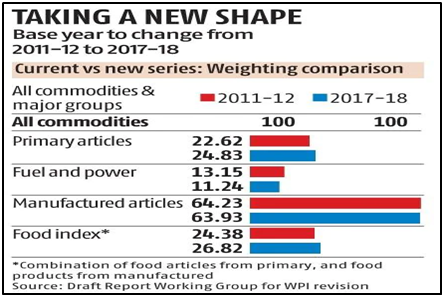Why in News?
The Department for Promotion of Industry and Internal Trade (DPIIT) is close to finalising a model to launch a Producer Price Index (PPI) in India that may eventually replace the Wholesale Price Index (WPI).
The government has been trying to determine the methodology for constructing a PPI in the Indian context for over two decades, the biggest challenge being finalising one that would make an improvement to the existing WPI.
What’s in Today’s Article?
- What is the Wholesale Price Index (WPI)?
- What is the Producer Price Index (PPI)?
- Challenges in Shifting from WPI to PPI
What is the Wholesale Price Index (WPI)?
- Definition: WPI represents the price of goods at a wholesale stage e. goods that are sold in bulk and traded between organisations instead of consumers, and is used as a measure of inflation in some economies.
- How is it calculated?
- WPIs are reported monthly in order to show the average price changes of goods.
- The total costs of the goods being considered in one year are then compared with the total costs of goods in the base year.
- The total prices for the base year are equal to 100 on the scale. Prices from another year are compared to that total and expressed as a percentage of change.
- WPI in India:
- It is used as an important measure of inflation in India and takes into account the change in price of goods only.
- WPI data is published by the Office of Economic Adviser, Ministry of Commerce and Industry, Government of India.
- The current series of WPI - with base year of 2011-12 - was the seventh revision of WPI and implemented from 2017 onwards.
- Major components of WPI:

- Primary articles, which is subdivided into Food Articles and Non-Food Articles (Oil Seeds, Minerals and Crude Petroleum).
- Fuel & Power, which tracks price movements in Petrol, Diesel and LPG.
- Manufactured goods comprise the biggest basket (Textiles, Apparels, Chemicals, Cement, Metals, Sugar and Tobacco Products, Vegetable and Animal Oils, etc)
- WPI Food Index: It is a sub-index within WPI, and includes Food Articles from the Primary Articles basket and the food products from the Manufactured Products basket.
- Significance of WPI: It is an easy and convenient method to calculate inflation and Fiscal and monetary policy changes are greatly influenced by changes in WPI.
- Criticism of WPI:
- It does not account for inflation at the level of the ordinary public because they do not buy products at wholesale prices.
- WPI excludes the service sector, which covers about 55% of GDP.
- WPI has an inbuilt bias due to double counting of the same product and doesn’t include exports and imports.
What is the Producer Price Index (PPI)?
- PPI measures wholesale prices from the point of view of producers of goods and services by tracking prices at different stages of production.
- It looks at inflation from the viewpoint of industry and business and measures price changes before consumers purchase final goods and services.
- It has replaced WPI in most countries as it is conceptually in line with the internationally agreed System of National Accounts (SNA) to compile measures of economic activity.
Challenges in Shifting from WPI to PPI:
- Likely to take more time: This is because the government would have to address the issues of -
- Preparing the right samples,
- Assigning the weighting, and
- Deciding on the periodicity (whether monthly or weekly) of the price collection.
- The biggest issue - To identify which services to include: What sort of services will serve as the correct representative of the sector?
- WPI is still the most widely followed measure of inflation:
- It is used as one of the deflators along with the Consumer Price Index (CPI) to calculate real GDP from nominal GDP.
- The government is separately working towards changing the current base year of 2011-12 for WPI.










